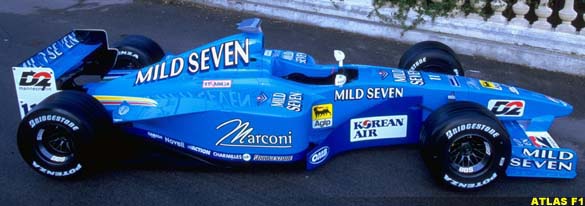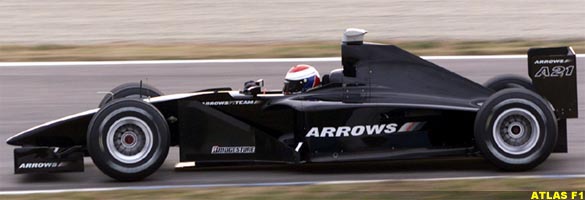|
| |||
 |
Technical Focus: Design trends for 2000 | ||
| by Will Gray, England | |||
|
The winter months have seen teams developing in evolution and finding innovation. In a two-part article, certified engineer Will Gray investigates who's done what in the technical world. This week - the chasing pack.
Jordan Is this the car to take this charismatic team two steps further to the title? It looks like it will have a damn good shot at it. The Jordan aim has clearly been minimisation this winter. The nose has dramatically slimmed. It remains of medium height, the top surface of the front chassis has dropped, and a bulge in front of the driver has developed to ensure good airflow around the cockpit area. A change to the front suspension has seen the team plump for torsion bars, which offer better packaging in the narrow front chassis. Jordan is another team to have followed the route of legality fins on the cockpit sides. The airbox intake is triangular, as the team believes this offers best use of the intake area allowed in the rules. It is again positioned quite far back from the driver's head, but from initial testing pictures appears to be quite low relative to the driver's head - which may lead to poor entry airflow. The car has retained its short sidepods, along with the side-impact wing structures required to achieve this. That also means the large McLaren-style bargeboards are not suitable for the Jordan, and it runs with smaller fences nestled in the front suspension. Meanwhile, at the rear of the sidepods is another design detail which runs against the top two teams - winglets. However, the team (as did a number of others) had two sets of engine covers last year, and swapped between winglets and flick-ups - a trend quite probable to continue this year. The engine is heavy compared to the leading powerplants, so the team have had to weight-save in areas such as the gearbox to compensate, and the team are also another to use the 'periscope' exhaust system. Providing the heavy powerplant doesn't let the team down, success could be on the cards with this, the leanest Jordan machine yet. Jaguar Stewart just pipped Williams to fourth place last year, now Jaguar take over the helm and aim to chase the top three. With the static regulations, the chasing pack might be expected to close up on the top three, so what have they all been doing to make the chase? New kids on the block? Don't you believe it! This car develops clearly from last year's Stewart, and unashamedly takes a number of design cues from the leading teams. The aim for Jaguar was to lower the centre of gravity - the nose has been lowered, as it was deemed necessary to compromise aerodynamics to reduce the centre of gravity in this area. The engine is a revised version of last year's Ford - lower and lighter. The cooling inlets in the sidepods appear to have reduced in size, the fuel tank - an achillies heel of Stewart in the past - has been enlarged, to allow more scope for strategy, and the team have developed a periscope exhaust system. The front chassis has lowered further, and the legality fins present last year have grown longer, whilst those by the cockpit have been replaced with higher cockpit sides, and McLaren-style channels. The airbox intake appears low to the driver's helmet, but is neater than on last year's Stewart, with narrower bodywork underneath and the now common legality 'ears'. The Jaguar retains large bargeboards, and flick-ups at the rear of the sidepods. Williams This year is one of trial for Williams and new engine manufacturer, BMW. So far, testing has not shown an amazing first powerplant from BMW, and predictions are for performance similar to the Supertec Williams have just got rid of! However, there are developments to come, and BMW will not rest until they are beating Mercedes! The Williams looks a chunky car. The nose is of medium height (a compromise between centre of gravity and aerodynamics) but is not lowered on the top chassis so has no legality fins. Around the cockpit, there is also no trimming of excess. Like the Jordan, the Williams sidepods are short and fairly square, with additional side impact structures, leading to the adoption a suspension-nested bargeboard similar to that on last year's car. The wide-topped sidepods end at the rear with a large flick-up. Mechanically, Williams have a brand new seven-speed gearbox, longitudinally mounted (as is standard practice) to allow a good diffuser design. The suspension consists of torsion bars front and rear. Benetton This year's Benetton retains the bulbous nose and high hefty sidepods of its predecessor, to give it a characteristically chunky look. Even the airbox intake above the driver's head looks like it has been squashed! Importantly, however, the Benetton has been on a diet, and although it doesn't look it, the car is significantly lighter than last year, allowing the team to use the ballast weight more effectively. The nose is lower, but not significantly thinner. The most important development in aerodynamics, however, is in the sidepods. Last year's distinctively large side impact wing structures and short sidepods have been replaced by the opposite Formula One design style - long sidepods with a large bargeboard. This, according to the team, offers an aerodynamic improvement. The Supertec engine has been developed, and the exhausts exit in the standard route through the rear suspension. Prost The AP03 hopes to take a leap from the 1999 car. It has touches of a number of different teams, combined with some unique features of its own. The top of the front chassis has significant legality fins, and the nose itself is quite low. A very large bargeboard leads to the high sidepods which, with a small intake area, suggest the Peugeot engine doesn't require as much cooling as some (a benefit in drag reduction). The unusual drooped sidepod front has disappeared, but the twin flick-ups at the rear remain. The top one picks up on air flowing over the top of the sidepod, the lower takes air from the side. In similarity to the top teams, the airbox intake above the driver's head is positioned far back, with a Ferrari-style headrest, whilst the Prost also uses Ferrari-esque periscope exhausts. The Peugeot engine is a new design, and is as small as the Mercedes and Jaguar powerplants, but believed not to be as powerful. Suspension is pretty standard torsion bar front, but has been repackaged for reduced centre of gravity. Sauber This is another car that had a fast over the winter, resulting in the loss of twenty-five to thirty kilogrammes of weight. This may be what the Sauber was crying out for last year, as the overall weight reduction will allow an essential increase in the use of ballast. The fuel tank is larger than average, and the Ferrari engine (whose spec is that of last year's Monza race) is lower and itself has a lower centre of gravity. It also requires less cooling and allows Sauber to reduce the sidepod intakes, thus reducing the drag. Other styling cues show a low nose - which is claimed to offer reduced drag and more downforce, although this is not thought to be a huge gain. The rear wing end fences, which featured last year, remain. They separate flow from the rear wheel and the top of the engine cover, allowing cleaner air to the rear wing. The main gain for Sauber is a loss of weight. It remains to be seen whether this was the loss that was required to start climbing back up the field. Arrows The Arrows engine project, which held the team back last year, has been replaced by Supertec engines, and this should be enough to bring the team up from the back end of the grid. Add to this a neat looking chassis, and the package begins to look significantly better than last year. The nose has been lowered, as has the front chassis top, and the cockpit sides have legality fins in the style of Ferrari and Jordan. The sidepods are quite wide, but low (good for the centre of gravity), and the sidepod inlets are relatively small. The large radiator exits, which were common to the last two Arrows cars, have disappeared due to the reduced requirement for cooling, but the car still looks quite bulky behind the driver. Also, quite unusually, the engine cover appears to have no flick-ups or winglets. Minardi Minardi have a problem. It's a big, heavy problem, and it sits right behind the driver. Their Ford customer engine is now two years old, and it seems that no matter how hard the team tries, it will never overcome this major disadvantage. The car itself looks neat, and everything that could be lowered has been. It has a very narrow and low nose, complete with the near-standard legality fins. The cockpit side channels are even more pronounced than McLaren's, and the airbox intake is very large. The radiator exits blow over the flick-ups at the rear of the sidepods, which are quite high and square and allow the use of a large bargeboard. The car incorporates the popular periscope exhausts, but continues with the same gearbox as last year. BAR Another team reliant upon a new engine, BAR expect the Honda to develop into something special, although initially they will run with a base engine. The Honda is completely different to the Mugen in the back of the Jordan, being (in typical engine development style) lighter and smaller. The reduced size and weight of the Honda in comparison to the Supertec allows a neater diffuser and more ballast positioning potential. Exhausts exit around the gearbox. With the nose appearing similar to last year's, the most significant visual development is the high sidepods. The large bargeboards scoop down to allow more air into the sidepods, and the large side-out panel at the rear of the sidepod suggests the Honda engine may need some significant cooling. The flick-up at the rear takes from the side of the sidepod, and has allowed the team to try out a Prost-style double flick-up since the car's launch. The cockpit sides follow the trend of having high sides with a channel, whilst the airbox inlet retains the trademark BAR circular shape. Part one of Will Gray's Technical Focus: Design trends for 2000 |
| Will Gray | © 2000 Kaizar.Com, Incorporated. |
| Send comments to: gray@atlasf1.com | Terms & Conditions |








